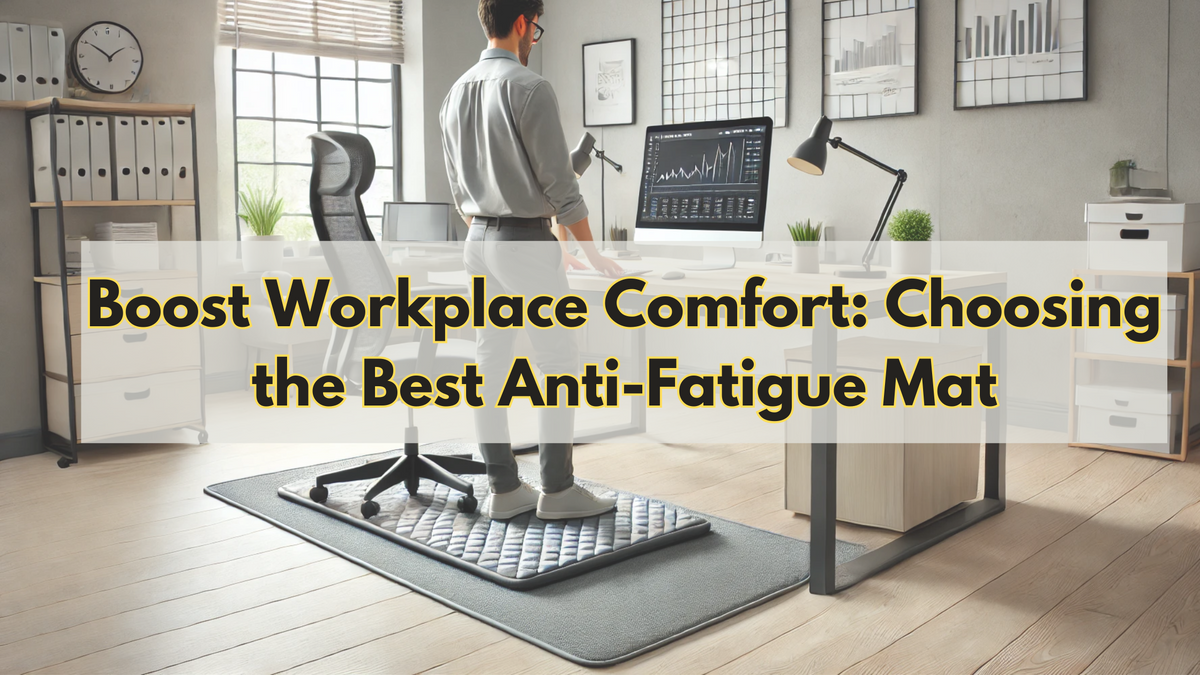How to Choose the Right Anti-Fatigue Mat for Your Workplace

When you work in an environment where standing for long hours is a part of your job, whether you’re at a standing desk, working in the retail industry, or in a kitchen, the physical strain can have a bad impact on your health. One of the simplest yet effective ways to mitigate the discomfort and fatigue associated with prolonged standing is by using an anti-fatigue mat. These specially designed mats provide cushioning and support to reduce strain on the muscles and joints, improving your overall comfort and Productivity. However, with a wide variety of mats available, it’s important to choose the right one for your specific needs. In this blog, we’ll introduce you to such factors which need to be considered while making the final decision.
How do these mats work?
Before getting into how to choose the right anti-fatigue mat, it’s important to understand what it is and how it functions. These mats are specially designed to reduce the stress caused due to prolonged standing. They achieve this by providing cushioned surfaces that help make smooth movements and relax the muscles of the legs and feet, hence improving circulation. When you stand on a hard surface for long periods, your muscles become fatigued because they are not engaging as effectively as they would if you were moving. Anti-fatigue mats reduce this strain by encouraging small movements, relieving pressure, and increasing blood flow in muscles.
Benefits of Anti-Fatigue Mats
Although there are numerous benefits of these mats, some of the common and important advantages are:
1. Improved Comfort: The primary benefit of an anti-fatigue mat is increased comfort while standing. The cushioning reduces pressure on the legs, feet, and lower back.
2. Enhanced Posture: Anti-fatigue mats help improve posture by encouraging more natural standing alignment and reducing cramps.
3. Long-term health benefit: Prolonged standing on hard surfaces can contribute to issues like back pain, poor circulation, and joint discomfort. Anti-fatigue mats help prevent these issues by providing support and comfort.
4. Increased Productivity: People standing for extended periods in discomfort keeps them unfocused from work and make productivity down. So delivering comfort is a part of anti-fatigue mats.
Factors to Consider When Choosing the Right Anti-Fatigue Mat
When it comes to selecting the right anti-fatigue mat for your workspace, several factors must be taken into consideration. These factors depend on your personal preferences, work environment, and the type of tasks you perform while standing. Below are the key factors you should consider before making your decision:
1. Material
The material of an anti-fatigue mat plays a significant role in its comfort, durability, and effectiveness. Common materials used in these mats include:
Foam: Foam mats are lightweight and provide excellent durability. They are commonly used in industrial or commercial settings due to their ability to withstand heavy wear and tear.
Rubber: Rubber mats are heavy-duty and provide excellent durability. They are commonly used in industrial or commercial settings due to their ability to withstand heavy wear and tear.
Gel: Gel anti-fatigue mats offer a premium cushioning experience. The gel absorbs shock and reduces stress on your feet and joints. These are mostly used in kitchen-like places.
Cork: Some mats use natural materials like cork or bamboo, which are eco-friendly and have an aesthetic appeal.
2. Thickness and Cushioning
The thickness of the mat is another crucial factor to be considered while selecting them. In general, the thicker the mat, the more cushioning it will provide. However, there’s a balance to be found. If the mat is too thick, it may be difficult to move around or may cause instability. Conversely, a thin mat may not offer enough support, so it's important to make a choice that is suitable for your needs.
3. Size and Shape
The Size of your anti-fatigue mat should support the area in which you’ll be standing. A larger mat is ideal for people who move around a bit or who require space to shift their weight as they stand.
4. Ease of Maintenance
Maintaining mats is easy when taken care of nicely. Some mats, especially those made from foam or gel, can absorb dirt and liquids, requiring frequent cleaning. Mats with a smooth surface or rubber coating tend to be easy to clean.
5. Aesthetic and Design
While functionality is important, the look of the mat can also play a role in your decision-making, particularly if the mat will be used in a visible area like an office or home. Many anti-fatigue mats now come in a range of colors, patterns, and textures, allowing you to choose a mat according to your taste and preference.
Conclusion
Choosing the right anti-fatigue mat for your workspace is crucial for improving comfort, reducing fatigue, and enhancing productivity. You can find a mat that suits your unique needs by considering factors such as material, thickness, size, non-slip backing, and design.
Invest in the right mat for your environment, and you’ll notice the difference in your comfort, energy levels, and productivity. Don’t let these factors affect your work and success. Make the right choice today that supports your health and professional life.










